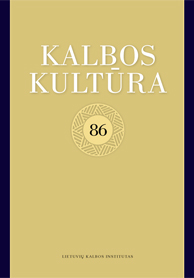Lietuvių kalbos fonologijos įsisavinimas: netikrų žodžių kartojimo eksperimentinis tyrimas
Acquisition of Lithuanian Phonology: Nonword Repetition Experimental Study
Author(s): Eglė Krivickaitė-Leišienė, Ineta DabašinskienėSubject(s): Phonetics / Phonology, Baltic Languages
Published by: Lietuvių Kalbos Institutas
Keywords: acquisition of phonology; nonword repetition test; syllable structure; natural phonology theory;
Summary/Abstract: A child’s capacity to repeat a new polysyllable word heard for the first time in the early age shows the ability to memorise new words and to expand one’s dictionary (Gathercole 2006a); therefore, the nonword repetition test is associated with language acquisition. It is stated that the repetition of nonwords starts very early in life when a child starts learning the first words (Gathercole 2006a): each word once heard by a child for the first time sounded unusual and new – like the words which are asked to be repeated in the nonword repetition test (Chiat, Roy 2007).The article presents a pilot experimental study carried out on the basis of nonword and word repetition tests. The Lithuanian Nonword Repetition Test was designed with due regard to the structural characteristics of Lithuanian words (word length, vowel and consonant frequency, syllable structure); the test consists of 24 nonwords of different structure. Each nonword is associated with a Lithuanian equivalent taking into account word length and syllable structure. The sample of the pilot study is made of 25 typically developing preschool and school-age children (from 4 to 9 years old).The results of the study revealed that the accuracy of repetition of nonwords and words is determined by three factors:1) syllable structure: most errors occur in the repetition of words and nonwords containing combinations of consonants. What is more, the accuracy of repetition of nonwords is also determined by the place where the consonant combination occurs: more errors occur in repeating words with a consonant combination in the middle of the word compared to those with a consonant combination in the beginning of the word. The place of consonant combination does not affect the accuracy of repetition of words;2) word length: the longer the word, the lower the accuracy of its repetition;3) age of participants in the study: the older the age group, the more accurately both shorter (one-two syllable) and longer (three-four syllable) words and nonwords are repeated.
Journal: Bendrinė kalba (iki 2014 metų – Kalbos kultūra)
- Issue Year: 2013
- Issue No: 86
- Page Range: 237-255
- Page Count: 19
- Language: Lithuanian

